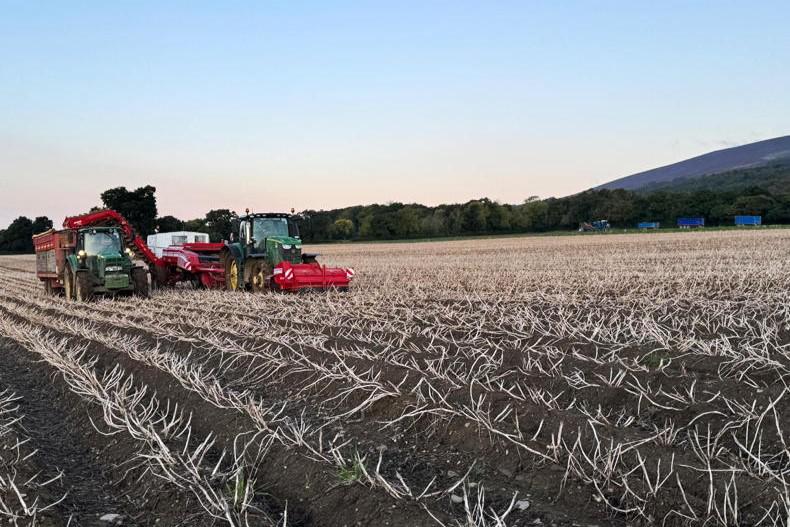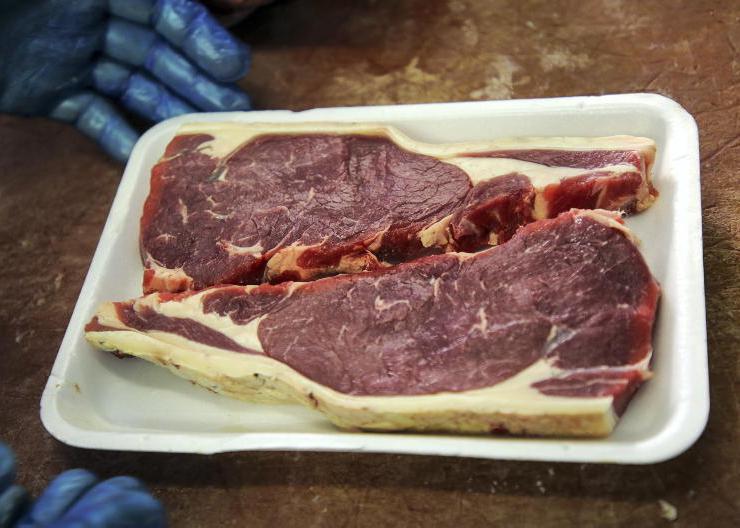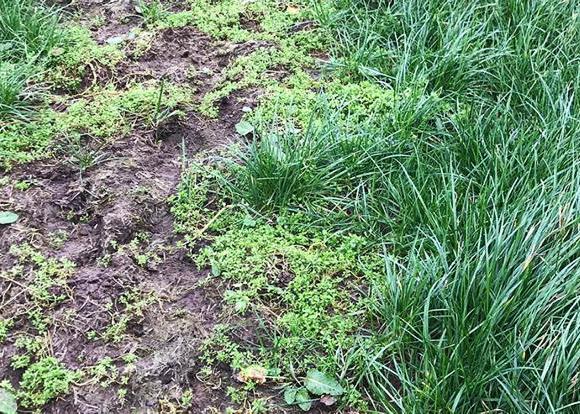Neill finished up planting winter cereals last week just before rain arrived. It was a very busy week for Neill as he harvested the maize and subsequently planted the fields with winter wheat straight afterwards.
The forage maize averaged 18.5t/ac over 130ac. This is not just an estimate as every load of maize is weighed because the crop is sold off-farm on a per-tonne basis. The crop also came in at 30% dry matter.
Neill has samples sent away to a lab for full analysis. He is delighted with the crop. He says it looked good all year and the bioplastic has proved itself again. It has provided big yields and also brought the harvest date forward, allowing the wheat to be planted afterwards and for the crop to be harvested in excellent conditions.

Neill’s son Henry giving the thumbs-up as the Canyon winter barley emerges.
With no tracks or clay brought on to the road during the maize harvest, the soil was in great condition to plant winter wheat.
The middle of the fields were ploughed and sown before the headlands were ploughed. Neill even managed to roll 80% of the wheat as the fields were so dry, showing the benefit of his dry land. This was mostly the field centres before the headlands were ploughed.
There have been no herbicides applied to the wheat as Neill usually leaves weed control until the springtime.
A post-emergence herbicide will be applied to the winter barley, which Neill says has emerged very nicely.
Sharp XD and Senpra XL will be applied in the coming days, and Neill thinks that he will include an aphicide too as it is still quite mild and he has suffered with BYDV in the past couple of years.
This will be the last fieldwork of the year for Neill, and he will then turn his attention to cleaning down machinery and machine maintenance.
Tom has made good progress recently, with only 40ac of winter wheat left to plant on the farm. The Belfry winter barley and Husky winter oats were both planted in ideal conditions, which Tom says is a nice change from the past two years.
The first of the barley is already up and looks good. The winter wheat will be all after oats and the varieties are Graham and Champion.
The last of the potato harvest was wrapped up a couple of weeks ago. Any of the potato fields to be planted with winter cereals have been drilled, while some fields are being left for maize.
The potato crop is back 10% to 15% this year, but the quality is good.
Tom says that using sprouted seed really paid for itself this year with the later planting date. All of the potatoes are now in store, where curing is being carried out, where required, before the temperature is reduced.
Tom is tipping away at the carrots. Straw will be rolled out on to the crops in the coming days to protect them from frost damage in the coming weeks.
The grass frost two weeks ago brought the foliage of the maize in a lot in the space of two days.
However, the cobs are still very immature, remaining milky and white. Therefore, the crop is still a while away from being ripe and Tom is trying to hold out for full maturity. The weather will have a big say in this in the coming week or two.
The grass cover crop that was planted after harvest was cut for silage a few weeks ago. The grass was allowed to wilt for 72 hours before baling. Tom hopes to get another cut from the crop in the spring before spraying it off and planting a spring crop.
Ground conditions have been great in Galway over the past few weeks, and Conall has finished planting all of his own winter cereals, with just 16ac left on hire.
With the winter barley and wheat planted, he decided to drill the WPB Isabel winter oats early in the first couple of weeks of October. Even though this is a bit risky, Conall says that you cannot refuse good conditions in his part of the country.
Conall does not think he will have any issues with the crop from planting it earlier than usual.
Most of the crops have now emerged and look very good, with full emergence, which is in stark contrast to some of last year’s crops. Last week, he applied post-emergence herbicides to his winter barley.
Most of the fields received Navigate at 0.3l/ha.
There were some fields that got Tower at 2l/ha, while Flight at 4l/ha was applied to a couple of fields that are known to have a good amount of groundsel in them.

Conall got a chance to try out his recently purchased Bateman sprayer with the post-emergence winter barley herbicide.
There have been no herbicides applied to the wheat or oats yet, but they may be applied in the coming week or two if the conditions allow.
This was the first time that Conall used his 24m self-propelled Bateman sprayer.
He says it is a game-changer for his business, allowing him to get through the work much more quickly.
He also says that the machine is very light on the ground, which should reduce soil compaction and be of great benefit in wetter times.
Conall says it’s great to have all his crops sown in good time and they should be nice crops to look at over the winter months.
He will also only have about 40ac of spring crops to plant, which should take a lot of pressure off and allow him to focus on the fertiliser and spray timings on the winter crops.
Neill finished up planting winter cereals last week just before rain arrived. It was a very busy week for Neill as he harvested the maize and subsequently planted the fields with winter wheat straight afterwards.
The forage maize averaged 18.5t/ac over 130ac. This is not just an estimate as every load of maize is weighed because the crop is sold off-farm on a per-tonne basis. The crop also came in at 30% dry matter.
Neill has samples sent away to a lab for full analysis. He is delighted with the crop. He says it looked good all year and the bioplastic has proved itself again. It has provided big yields and also brought the harvest date forward, allowing the wheat to be planted afterwards and for the crop to be harvested in excellent conditions.

Neill’s son Henry giving the thumbs-up as the Canyon winter barley emerges.
With no tracks or clay brought on to the road during the maize harvest, the soil was in great condition to plant winter wheat.
The middle of the fields were ploughed and sown before the headlands were ploughed. Neill even managed to roll 80% of the wheat as the fields were so dry, showing the benefit of his dry land. This was mostly the field centres before the headlands were ploughed.
There have been no herbicides applied to the wheat as Neill usually leaves weed control until the springtime.
A post-emergence herbicide will be applied to the winter barley, which Neill says has emerged very nicely.
Sharp XD and Senpra XL will be applied in the coming days, and Neill thinks that he will include an aphicide too as it is still quite mild and he has suffered with BYDV in the past couple of years.
This will be the last fieldwork of the year for Neill, and he will then turn his attention to cleaning down machinery and machine maintenance.
Tom has made good progress recently, with only 40ac of winter wheat left to plant on the farm. The Belfry winter barley and Husky winter oats were both planted in ideal conditions, which Tom says is a nice change from the past two years.
The first of the barley is already up and looks good. The winter wheat will be all after oats and the varieties are Graham and Champion.
The last of the potato harvest was wrapped up a couple of weeks ago. Any of the potato fields to be planted with winter cereals have been drilled, while some fields are being left for maize.
The potato crop is back 10% to 15% this year, but the quality is good.
Tom says that using sprouted seed really paid for itself this year with the later planting date. All of the potatoes are now in store, where curing is being carried out, where required, before the temperature is reduced.
Tom is tipping away at the carrots. Straw will be rolled out on to the crops in the coming days to protect them from frost damage in the coming weeks.
The grass frost two weeks ago brought the foliage of the maize in a lot in the space of two days.
However, the cobs are still very immature, remaining milky and white. Therefore, the crop is still a while away from being ripe and Tom is trying to hold out for full maturity. The weather will have a big say in this in the coming week or two.
The grass cover crop that was planted after harvest was cut for silage a few weeks ago. The grass was allowed to wilt for 72 hours before baling. Tom hopes to get another cut from the crop in the spring before spraying it off and planting a spring crop.
Ground conditions have been great in Galway over the past few weeks, and Conall has finished planting all of his own winter cereals, with just 16ac left on hire.
With the winter barley and wheat planted, he decided to drill the WPB Isabel winter oats early in the first couple of weeks of October. Even though this is a bit risky, Conall says that you cannot refuse good conditions in his part of the country.
Conall does not think he will have any issues with the crop from planting it earlier than usual.
Most of the crops have now emerged and look very good, with full emergence, which is in stark contrast to some of last year’s crops. Last week, he applied post-emergence herbicides to his winter barley.
Most of the fields received Navigate at 0.3l/ha.
There were some fields that got Tower at 2l/ha, while Flight at 4l/ha was applied to a couple of fields that are known to have a good amount of groundsel in them.

Conall got a chance to try out his recently purchased Bateman sprayer with the post-emergence winter barley herbicide.
There have been no herbicides applied to the wheat or oats yet, but they may be applied in the coming week or two if the conditions allow.
This was the first time that Conall used his 24m self-propelled Bateman sprayer.
He says it is a game-changer for his business, allowing him to get through the work much more quickly.
He also says that the machine is very light on the ground, which should reduce soil compaction and be of great benefit in wetter times.
Conall says it’s great to have all his crops sown in good time and they should be nice crops to look at over the winter months.
He will also only have about 40ac of spring crops to plant, which should take a lot of pressure off and allow him to focus on the fertiliser and spray timings on the winter crops.











SHARING OPTIONS